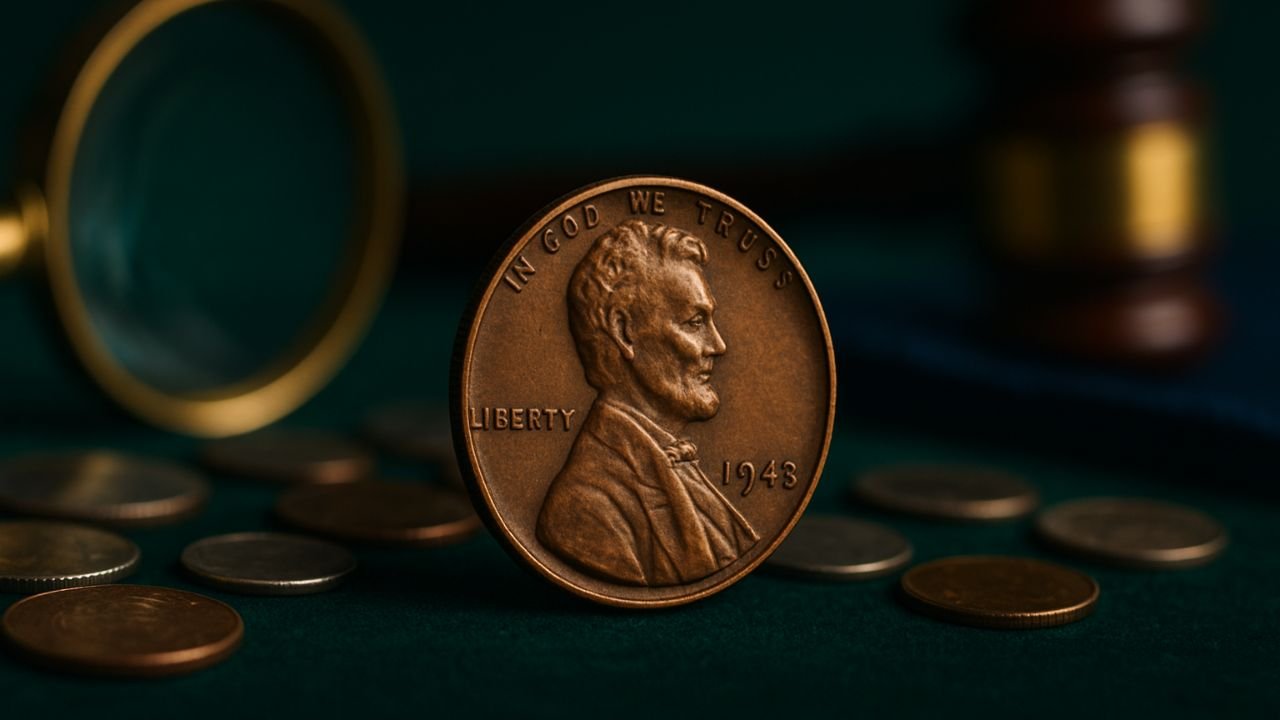During World War II, the U.S. Mint switched from copper to zinc-coated steel for 1943 cents to conserve copper for the war effort.
A tiny number of leftover bronze (copper) planchets were accidentally struck with 1943 dies.
These 1943 bronze Lincoln Wheat cents are among the most famous wrong-planchet errors in U.S. coinage and can sell for $100,000–$250,000+ depending on grade and mint.
Exceptional, well-certified examples have even reached seven-figure prices at auction.
Key Dates And Valuable Look-Alikes
Beyond the 1943 bronze cent, collectors also hunt the 1944 steel cent—another year-mixup rarity created when a few steel planchets were struck after copper returned in 1944.
Classic key dates like 1909-S VDB Wheat cents are always in demand, though most don’t reach six figures unless they are in elite grades.
How To Tell If Your 1943 Penny Is Rare
Use these fast, at-home checks before you contact a professional:
- Magnet Test: Common 1943 steel cents stick to a magnet. A genuine 1943 bronze does not.
- Weight Test: Bronze cents weigh about 3.11 g; steel cents around 2.7 g. Use a digital scale.
- Color & Surface: Bronze shows copper/reddish-brown tones; steel appears gray/silvery (often with a thin zinc coating).
- Mint Marks: You may see no mint mark (Philadelphia), D (Denver), or S (San Francisco). Any 1943 bronze from these mints is valuable, with the Denver (D) issue historically setting record prices.
- Don’t Clean: Cleaning can permanently reduce value and make grading harder.
Market Snapshot And Value Drivers
The value of a 1943 bronze Wheat cent depends on authenticity, grading service certification, numeric grade (sheen, luster, strike), and auction demand at the time of sale.
Mid-grade authenticated coins often realize low- to mid-six figures; top-grade, finest-known examples can command far more.
The common 1943 steel cents are typically worth face value to a few dollars in circulated condition, but high-end Mint State steel cents (especially with superb eye appeal) can bring stronger prices from registry collectors.
Quick Reference
| Coin / Variety | Metal & Quick ID | Typical Weight | Typical Value Range* | Notes |
|---|---|---|---|---|
| 1943 Bronze (Copper) Wheat Cent | Non-magnetic, copper color | ~3.11 g | $100,000–$250,000+ | Wrong-planchet error; ultra-rare. |
| 1943 Steel Wheat Cent | Magnetic, gray/silvery zinc | ~2.7 g | Face–$20 (circulated), more if top Mint State | Standard wartime issue; billions made. |
| 1944 Steel Wheat Cent | Magnetic in a copper year | ~2.7 g | Five–six figures in high grade | Another wrong-planchet rarity; very few known. |
| 1909-S VDB Wheat Cent | “S” mint mark, “V.D.B.” on reverse | ~3.11 g | Hundreds–five figures by grade | Key date; popular with all collectors. |
*Ranges are typical historical outcomes; actual prices vary by certification, grade, and auction demand.
What To Do If You Think You Found One
- Do basic tests (magnet and weight).
- Avoid cleaning or polishing at all costs.
- Seek professional authentication from a top third-party grading service (e.g., PCGS/NGC).
- Consider auctioning a certified coin through a reputable house to reach serious bidders.
Common Myths, Debunked
- “All 1943 pennies are rare.” False. Most 1943 cents are steel and worth little in circulated condition.
- “Any Wheat cent can hit $250,000.” Only a few documented error varieties—especially the 1943 bronze and 1944 steel—reach six figures.
- “Cleaning improves value.” Cleaning usually destroys value and can void grading guarantees.
A $250,000 Lincoln Wheat Penny is real—but it’s the 1943 bronze error, not the common steel coin.
If your 1943 cent doesn’t stick to a magnet, weighs ~3.11 g, and shows copper color, you may have a once-in-a-lifetime find.
Confirm with professional grading, then explore auction options to realize its full potential.
Most pocket finds will be ordinary, but careful testing could turn spare change into a remarkable payoff.
FAQs
How many 1943 bronze cents exist?
Only a handful are known from each mint, which is why prices are so high. Exact counts vary as new discoveries are authenticated.
Can a 1943 steel cent be valuable?
Yes, but mainly in top Mint State grades with superb eye appeal. Circulated steel cents are generally modest in value.
What increases my coin’s price the most?
Certification by a leading grader, a high numeric grade, and strong eye appeal—plus selling through a reputable auction with motivated bidders.

